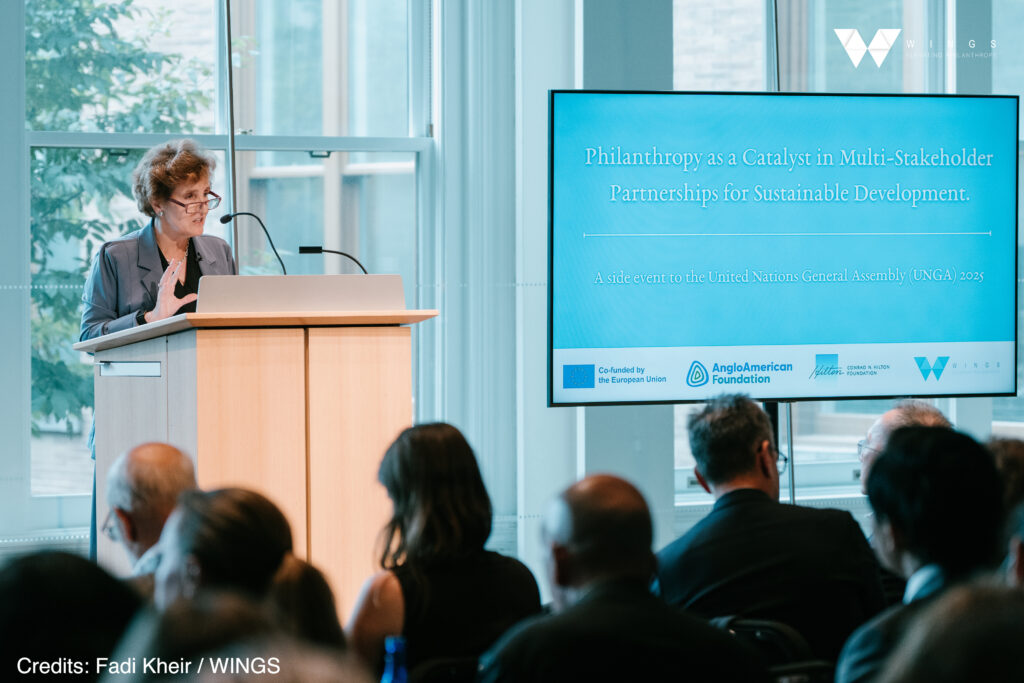Amid Official Development Assistance Cuts and Increasing Leadership of the Locally Led Development Movement, Philanthropic Sector Considers Opportunities to Make a Difference
As the global development community responds to a period of profound disruption, including the shock of losing USAID, an event took place on the sidelines of the 80th Session of the United Nations General Assembly (UNGA) to discuss what could happen next. Co-hosted by WINGS, the Conrad N. Hilton Foundation, the Anglo American Foundation, and the European Union, the event, titled ‘Philanthropy as a Catalyst in Multi-Stakeholder Partnerships’, brought together government, multilateral, private sector, and philanthropic leaders to explore how partnerships can drive more inclusive, locally led development.

Among the resources shared with participants was “A Strategic Note for Philanthropy: Development Finance Post-Seville” by Alice Albright, former Chief Executive Officer, The Millennium Challenge Corporation. In the note, Albright summarized key observations from the Fourth International Conference on Financing for Development (FfD4) which took place in late June 2025 in Sevilla, Spain to advance solutions to the financing challenges threatening sustainable development. She reflected on the critical role of philanthropy in development finance due to its independence and flexibility – especially as the development world “regroups and adapts to a ‘new normal.’”
While philanthropy cannot fully replace the scale of Official Development Assistance (ODA), the focus will shift toward specificity, measurable impact, and financial efficiency. One promising approach for funders is to adopt investment-oriented partnerships with governments and non-governmental actors that clearly define outcomes, timelines, and exit strategies.
The outcome document for the FfD4 —the “Compromiso de Seville” — called for diversifying development funding. Speakers at the conference called for reforms that would release capital and find new sources of funding and expressed a desire for the private sector (including for-profit entities, foundations, or capital markets) to become more involved, partner more, and provide more capital to fill the gaps.
Blended finance is often considered a new source for development but faces critiques that it has not met expectations in terms of its potential volume and scale. Some stakeholders believe philanthropy can provide risk mitigation for blended finance providers and other sources of private capital. Although the FfD4 outcome document mentioned philanthropy only once, Albright said there is a “clear recognition that the sector will have an important role to play” and some governments have voiced a desire to work more closely with philanthropy.
Networks of philanthropies, such as WINGS, are poised to function as vital connectors, facilitating collaboration at global, regional, and national levels. To help the sector achieve greater scale and effectiveness, further investments are needed to map the philanthropic ecosystem and build stronger links between funders and opportunities. Understanding and leveraging local capital markets and philanthropic communities is increasingly important, providing benefits such as improved currency alignment compared to traditional cross-border capital flows.
While technology continues to create disparities in access, it is also an essential driver for improving core service delivery—especially in countries experiencing rapid population growth. Identifying, researching, and testing new technological solutions represents a major opportunity for the philanthropy sector to deliver better outcomes for vulnerable populations. As philanthropy adapts and innovates, its impact will be defined by its agility in building local partnerships, supporting targeted investments, and leveraging data and technology to address the world’s most pressing challenges.
Read the full document for additional insights.